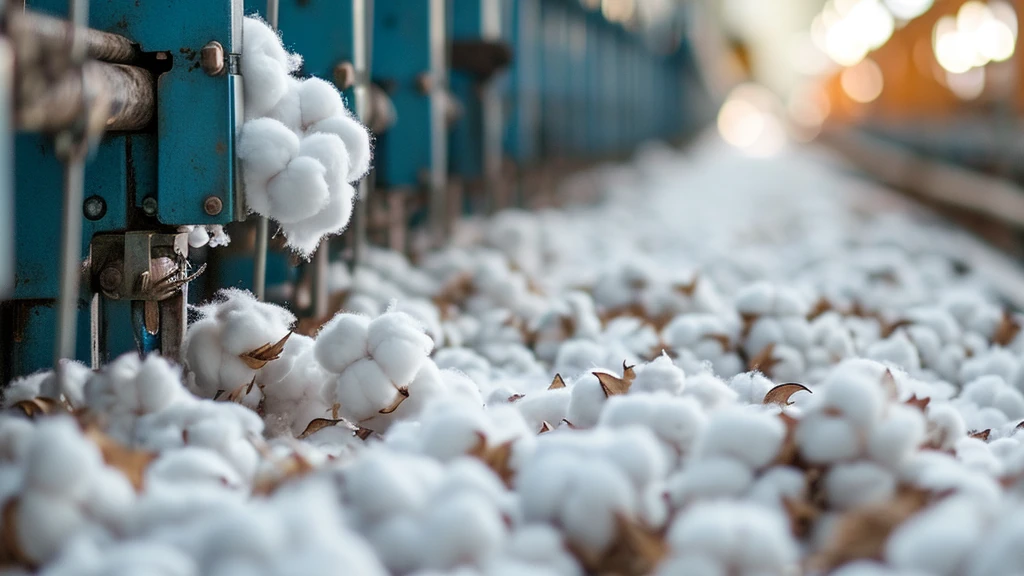Decoding the Green Revolution - The Power of Organic Cotton
Welcome back to the second installment of our Textile Guide series, where we embark on a comprehensive exploration of the cotton production process. We introduce you to the intricacies of conventional and organic cotton, laying the foundation for a deeper understanding of their environmental footprints.
From the sun-drenched cotton fields to the bustling looms, we’ll decode the complexities, comparing the conventional and organic routes at every turn.
So, fasten your seatbelts as we navigate the sustainable threads of cotton production. Whether you’re a conscious consumer, a sustainability enthusiast, or a curious mind, this guide is your passport to understanding the journey of one of the world’s most beloved textiles. Let’s unravel the tapestry of cotton production, stitch by stitch, and discover the pathways toward a more sustainable and eco-conscious textile industry.
Cotton Farming: Conventional Strides vs. Organic Harmony
Conventional Cotton:
In the world of conventional cotton, vast fields witness the use of synthetic pesticides and fertilizers. Imagine a landscape where efficiency often takes precedence over ecological considerations. High-yield varieties dominate, but at a cost to soil health and biodiversity.
Organic Cotton:
Contrast this with the organic fields, where biodiversity thrives. Visualize a harmonious coexistence between cotton plants and other beneficial organisms. Organic cotton farming avoids synthetic chemicals, relying on natural fertilizers and pest control methods. It’s a dance with nature, where sustainability is not just a goal but a way of life.
Harvesting: Mechanized Efficiency vs. Handcrafted Precision
Conventional:
In the realm of conventional cotton, efficiency is key. Modern machinery efficiently collects cotton fibers, often at the expense of a personal touch. Imagine the hum of mechanical harvesters echoing across vast plantations, streamlining the process but potentially causing environmental disruption.
Organic:
On the organic side, envision skilled hands delicately plucking cotton. Picture the respect for each plant as human labor takes center stage. Organic harvesting not only minimizes environmental impact but also supports local economies with labor-intensive practices.

Ginning: Energy-Intensive Separation vs. Sustainable Innovation
Conventional:
Enter the conventional cotton gin, where efficiency drives the separation of fibers from seeds. This stage contributes significantly to energy consumption, reflecting the reliance on high-tech, energy-intensive processes.
Organic:
In the organic world, envision a more sustainable approach to ginning. While machinery may still play a role, the emphasis is on reducing energy consumption and exploring innovative, eco-friendly separation methods.
Spinning and Weaving: Industrial Precision vs. Artisanal Craftsmanship
Conventional:
As we transition to spinning and weaving, think of large industrial facilities churning out mass quantities of fabric. The focus is on precision and volume, with the energy-intensive nature of these processes reflecting the demands of high-speed production.
Organic:
In the organic realm, visualize a more artisanal approach. Smaller-scale operations prioritize quality over quantity, embracing eco-friendly technologies and manual craftsmanship. It’s a nod to tradition in a world increasingly driven by industrialization.
Conventional:
In the conventional dyeing arena, imagine vibrant colors infused into the fabric, often at the expense of environmental considerations. High water consumption and chemical discharge characterize this stage, contributing to pollution concerns.
Organic:
Contrast this with organic dyeing, where the emphasis is on natural hues. Picture a palette of colors derived from plant-based dyes, with a mindful approach to water use and minimal chemical impact. It’s a celebration of nature’s vibrancy without compromising on sustainability.
Green or Gray: The Environmental Footprint of Cotton Production
While conventional cotton production contributes significantly to greenhouse gas emissions, water consumption, and chemical usage, organic cotton presents a more sustainable alternative with notable reductions in these environmental impacts. These statistics emphasize the potential benefits of transitioning to organic cotton for a more environmentally friendly and sustainable textile industry.
| Environmental Factor | Conventional Cotton | Organic Cotton |
|---|---|---|
| CO2 Emissions (per kg of cotton) | ~ 5 kg | ~ 2 kg |
| Water Usage (per kg of cotton) | 20,000 to 22,000 liters | 12,000 to 15,000 liters |
| Chemical Usage (per kg of cotton) | ~ 200 grams | ~ 50 grams |
| Energy Consumption (per kg of cotton) | ~ 20 MJ | ~ 12 MJ |
Conclusion: Balancing Choices for a Sustainable Future
In the journey from farm to fabric, the environmental impact of conventional and organic cotton production differs significantly. While conventional methods often prioritize efficiency and high yields, they may come at the cost of higher resource consumption and environmental degradation. On the other hand, organic cotton production, with its focus on sustainability and natural processes, strives to minimize environmental impact at each stage.
As consumers, understanding these differences empowers us to make informed choices that align with our values. Whether it’s supporting organic cotton for its reduced ecological footprint or advocating for sustainable practices in conventional farming, every decision contributes to shaping a more sustainable future for the textile industry. Let’s continue to explore, question, and support practices that foster environmental stewardship in the cotton production landscape.
Top 3 Countries in Cotton Production: A Global Perspective
Conventional Cotton:
China:
As the world’s largest producer of conventional cotton, China and its vast agricultural landscape, favorable climate, and advanced farming techniques contribute to high yields. The scale of cotton production in China, often using conventional methods, raises concerns about chemical usage and its impact on local ecosystems.
India:
A significant player in conventional cotton production, India is known for its extensive cotton farms. The country’s warm climate and large agricultural workforce contribute to its prominence in the global cotton market. Intensive cultivation practices in some regions may involve the use of synthetic pesticides and fertilizers, impacting soil and water quality.
United States:
Particularly in states like Texas has a robust cotton industry . Modern farming practices and advanced technology contribute to high yields of conventional cotton. While some U.S. cotton farms adopt sustainable practices, the overall conventional production may involve the use of agrochemicals, requiring careful environmental management.
Organic Cotton:
India:
The leader not only in conventional but also in organic cotton production. The country has embraced organic farming practices, driven by a growing demand for sustainable and eco-friendly textiles. Organic cotton farming in India focuses on minimizing chemical inputs, promoting biodiversity, and ensuring sustainable land management.
Turkey:
As a significant player in organic cotton production, Turkey has emerged with a commitment to sustainable agriculture. The country’s diverse climate and agricultural practices support the growth of organic cotton. Organic cotton cultivation in Turkey emphasizes natural methods, reducing reliance on synthetic chemicals and promoting environmentally friendly practices.
China:
Not only dominates conventional cotton production but has also made strides in organic cotton cultivation. The country’s commitment to sustainable practices has led to an increase in organic farming initiatives. Organic cotton farming in China aims to address environmental concerns associated with conventional methods, promoting soil health and reducing chemical impact.
FAQ: Conventional vs. Organic Cotton Production
Q1: Why does conventional cotton contribute to CO2 emissions?
Conventional cotton production contributes to CO2 emissions mainly due to the use of synthetic fertilizers, pesticides, and energy-intensive processing. The production and application of these inputs, along with machinery usage, contribute to the carbon footprint.
Q2: How does organic cotton reduce CO2 emissions?
Organic cotton reduces CO2 emissions by avoiding synthetic fertilizers and pesticides. The use of natural inputs and sustainable farming practices results in a lower carbon footprint. Additionally, healthier soil in organic farming acts as a carbon sink.
Q3: Is water usage significantly different between conventional and organic cotton?
Yes, conventional cotton farming often requires more water, especially through irrigation. Organic cotton, with its focus on rain-fed water and efficient irrigation, can significantly reduce water consumption compared to conventional methods.
Q4: Are chemicals used in organic cotton production?
While chemicals are used in organic cotton farming, they are limited to natural alternatives. Organic cotton prohibits the use of synthetic pesticides and fertilizers, reducing environmental and health risks associated with chemical usage.
Q5: How do pesticides in conventional cotton impact the environment?
The use of synthetic pesticides in conventional cotton can lead to soil degradation, water pollution, harm to beneficial insects, and negative impacts on biodiversity. Runoff from fields can contribute to environmental pollution.
Q6: Does organic cotton cost more to produce?
Initially, organic cotton production may have higher costs due to manual labor and natural inputs. However, over time, as demand grows and economies of scale come into play, organic cotton costs can become more competitive.
Q7: Does organic cotton production use less energy?
Yes, organic cotton production often involves less energy-intensive processes, especially when smaller-scale operations and manual craftsmanship are employed. This can result in a lower overall energy demand compared to conventional cotton.





